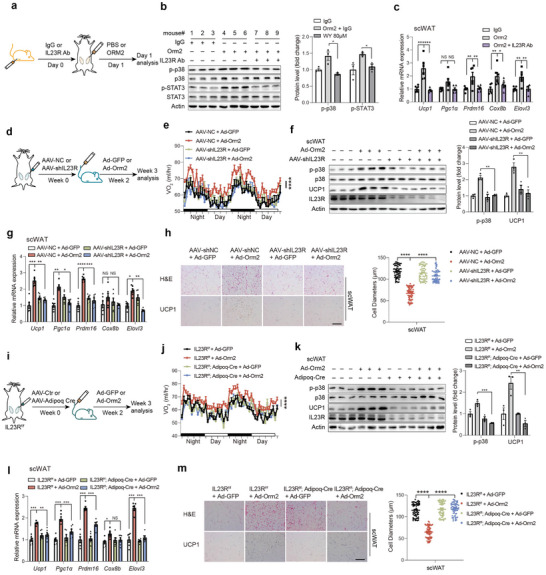Figure 4.

Orm2 promotes adipose browning through IL23R. a–c) C57BL/6 mice were subcutaneously injected with IL23R antibody or control IgG (500 µg kg−1), followed by an injection of recombinant Orm2 (5 mg kg−1) directly into the subcutaneous white adipose tissue (scWAT). Schematic depicting the workflow for the mice treatment (a) and representative immunoblots of STAT3 phosphorylation and p38 phosphorylation levels in scWAT (b), thermogenic genes mRNA levels in scWAT (c; n = 3) were detected. d–h) C57BL/6 mice were locally injected with AAV‐NC or AAV‐shIL23R in scWAT followed by injection of Ad‐GFP or Ad‐Orm2 intravenously. Schematic depicting the workflow for the mice treatment (d) and Oxygen consumption (VO2) (e; n = 6), immunoblots of p38 phosphorylation and Ucp1 protein levels in scWAT (f), thermogenic genes mRNA levels of scWAT (g; n = 6), H&E and Ucp1 staining of scWAT (h; Scale bar,100 µm, n = 3) were detected. i–m) IL23R f/f mice were locally injected with AAV‐Ctr or AAV‐Adipoq Cre into scWAT followed by injection of Ad‐GFP or Ad‐Orm2 intravenously. Schematic depicting the workflow for the mice treatment (i) and Oxygen consumption (VO2) (j; n = 6), immunoblots of p38 phosphorylation and Ucp1 protein levels in scWAT (k), thermogenic genes mRNA levels of scWAT (l; n = 6), H&E and Ucp1 staining of scWAT (m; Scale bar,100 µm) were detected. Significance was calculated by unpaired two‐tailed Student's t test (b, c, f‐h, k‐m) or two‐sided ANCOVA (e, j); *p < 0.05, **p < 0.01, ***p < 0.001 and ****p < 0.0001 were considered to be significant. Error bars represent the mean ± SEM.
